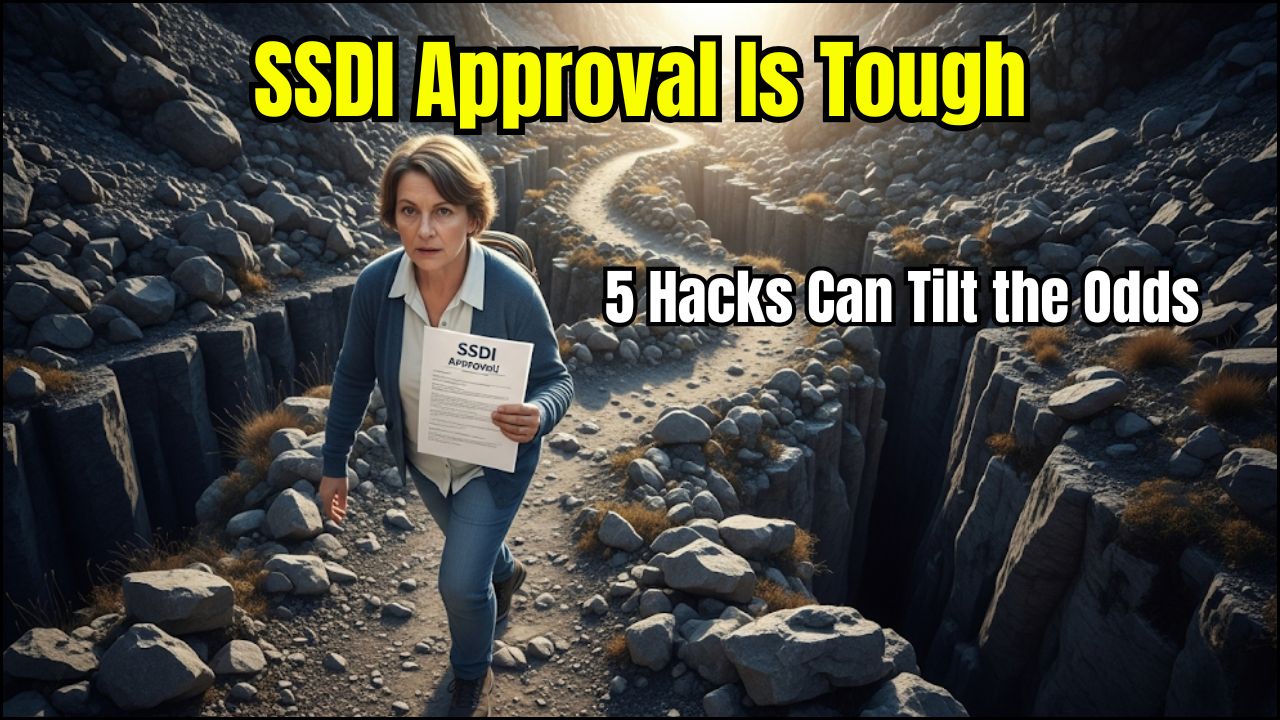Navigating the process of Social Security Disability Insurance (SSDI) approval can feel like trekking through a maze of paperwork, medical exams, and long wait times. SSDI is a federal program that provides benefits to people who are unable to work due to a severe disability, but getting approved can be tough. The approval rate for initial SSDI claims is only around 22%, and this number can be even lower depending on the specific situation.

However, don’t let that discourage you! With the right strategies, you can increase your chances of getting approved. We’ve put together five essential hacks that can tilt the odds in your favor, breaking down the process and offering practical advice that is easy to follow. Whether you’re applying for SSDI for the first time or appealing a denial, these tips will help you navigate the path more effectively and improve your chances of success.
SSDI Approval Is Tough
| Key Factor | Details |
|---|---|
| Approval Rate | Initial SSDI claims are approved at a rate of around 22%, but with the right approach, your chances can improve. |
| Essential Documentation | Medical records, treatment history, and proof of disability severity are crucial for a successful SSDI claim. |
| Professional Help | Hiring an SSDI attorney or advocate increases approval chances by ensuring your application is complete and well-prepared. |
| Appeals Process | If denied, you can appeal with a reconsideration request or a hearing before an administrative law judge, where additional evidence can be submitted. |
| Time Frames | The application process can take months, and appeals can take even longer, so patience is key. |
| Official Resources | For official guidelines and support, visit SSA.gov. |
Securing approval for Social Security Disability Insurance (SSDI) can be tough, but with the right strategies, you can increase your chances of success. By understanding the SSA’s criteria, gathering comprehensive medical documentation, filing your application promptly, considering professional help, and preparing for the appeals process, you’ll be in a stronger position to navigate this complex system.
Remember, SSDI is there to help individuals who are struggling with severe disabilities, and knowing the right steps to take can ensure that you get the benefits you deserve.
What Is SSDI and Why Is It So Important?
Social Security Disability Insurance (SSDI) is a government program designed to help people who cannot work because of a disability. SSDI benefits are not based on financial need, but rather on your work history and the severity of your disability. If you’ve worked for a certain number of years and have paid into the Social Security system through payroll taxes, you may qualify for SSDI.
The application process can be daunting. Whether you’re new to the system or you’ve applied before, there are certain things that can increase your chances of getting approved for SSDI. Let’s take a closer look at five proven hacks that can make all the difference.
1. Make Sure Your Disability Meets SSA Criteria
Before you even start the application process, it’s important to know whether your disability qualifies under the Social Security Administration’s (SSA) criteria. SSDI is designed for people with serious, long-term disabilities that prevent them from working.

The SSA has a Blue Book that lists all the conditions that may qualify for SSDI. If your condition is listed there, you have a better shot at approval. However, if your condition isn’t specifically listed, you can still qualify if it’s severe enough to keep you from performing daily activities or working.
For example:
- Back pain: A common condition that can qualify for SSDI if it’s severe enough and prevents you from performing any meaningful work.
- Mental health conditions: Issues like depression or anxiety can qualify, but they need to be severe enough to impact your ability to perform basic work tasks.
2. Gather Thorough and Up-to-Date Medical Documentation
One of the most important aspects of your SSDI claim is medical documentation. The SSA requires clear evidence of your disability, so you’ll need a detailed medical record that shows the severity of your condition.
Make sure to:
- Visit your doctor regularly: The more records you have showing continuous treatment for your condition, the stronger your case will be.
- Request your medical records: Ensure that all the details of your disability—such as test results, diagnoses, and treatment plans—are included.
- Keep a symptom journal: Record how your disability affects you day-to-day, including any limitations it imposes on your ability to work or function in daily life.
The more comprehensive and up-to-date your records are, the better. Medical records serve as the backbone of your SSDI application, and having thorough documentation can significantly speed up the approval process.
3. File Your Application as Soon as Possible
Many people put off applying for SSDI, assuming it’s something that can wait. However, filing your application as soon as possible can be an important step toward approval. SSDI benefits typically start five months after your disability begins, so waiting only delays the process.

It’s also crucial that your application is complete and accurate from the start. A single mistake or missing document can delay your approval for months. Here are some tips to help you get started:
- Use the online application tool: The Social Security Administration offers an easy-to-use online application portal. It’s convenient and makes it easier to track your application’s progress.
- Double-check your information: Ensure that all personal and medical information is accurate. Small errors can cause big delays.
4. Hire a Professional SSDI Advocate or Attorney
It may seem like an extra expense, but hiring a professional SSDI advocate or attorney can drastically improve your chances of getting approved. SSDI attorneys are experts in the field who know the ins and outs of the application process. They can:
- Help you gather and organize medical records.
- Guide you through the complex paperwork and deadlines.
- Represent you at hearings if your claim is denied and you need to appeal.
Statistics show that applicants who have legal representation are twice as likely to be approved for SSDI. While hiring an attorney is an investment, it can pay off in the long run. SSDI attorneys typically work on a contingency fee basis, meaning they only get paid if you win your case. This makes it a risk-free option for many applicants.
5. Prepare for the Appeals Process
Unfortunately, not all SSDI applications are approved on the first try. In fact, about 70% of initial claims are denied. But don’t give up—there’s still hope.
If your claim is denied, you have the right to appeal the decision. Here are the main stages of the appeals process:
- Request for Reconsideration: This is the first level of appeal, where you ask the SSA to review your application again with any new evidence.
- Hearing before an Administrative Law Judge: If reconsideration is denied, you can request a hearing before a judge, where you can present additional evidence or testimony.
- Appeals Council: If the judge denies your claim, you can request a review by the Appeals Council.
- Federal Court: As a last resort, you can file a lawsuit in federal court if your claim is denied at all previous levels.
The appeals process can be long, but it’s important to stay patient and persistent. During this process, you can submit more documentation or seek help from your attorney to strengthen your case.
FAQs
Q: How long does the SSDI application process take?
A: The application process can take anywhere from three to five months. If your application is denied and you decide to appeal, the process can take longer.
Q: How do I know if my condition qualifies for SSDI?
A: Check the SSA’s Blue Book, which lists all qualifying conditions. If your condition isn’t listed, you may still qualify if it prevents you from working.
Q: Can I work while applying for SSDI?
A: You can work while applying, but there are limits on how much you can earn. In 2025, you cannot earn more than $1,470 per month (or $2,460 if you’re blind) and still qualify for SSDI.
Q: What happens if my SSDI application is denied?
A: You can appeal the decision through a reconsideration, a hearing, an Appeals Council review, and even federal court if necessary.












